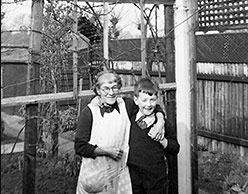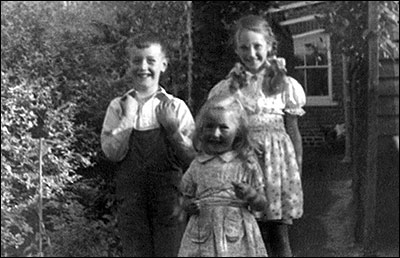|
Introduction
At the beginning of World War II I was living with my parents in Harrow Weald which is in the London suburbs and it was decided that I would be privately evacuated to my maternal grandparents, Alfred and Florence Loak who lived in Burton Latimer.
My granddad was born in Burton Latimer but my Grandma who years later I was told was actually my step-grandma, my own mother's mother died the day after she was born from complications caused by her birth. Her maiden name was Hobbs and I found out I was related to some of the Hobbs but more of that later. My granddad remarried later in London, he met my grandma in Burton Latimer as she was working in service at Burton Latimer Hall but actually came from London. Her maiden name was Smith and they had a daughter Avis who was born in 1904 and was married to George Butlin and lived at 47 Meeting Lane. They had two children, Angela who was two months older than me and Pamela who was four years younger.
My granddad had a real Northamptonshire accent, for example a chair was “a cheer” and go was “Gew” but my grandma kept her London accent and told me that was the correct way to speak.
I thought I came in 1940 but I do remember being with my mother in Burton Latimer for her 40th birthday which was on October 26 1939 so I could have gone earlier unless this was just a brief visit?
The first thing I remember was going with my father to St Pancras station to catch the LMS train to Kettering but he told me we could not go because the lines had been bombed and no trains were running that day. Consequently we went to Euston taking a train to Northampton and getting a bus from there to Kettering and then the usual United Counties bus from there to Burton Latimer.
My grandparents lived at 70 Station Road and I was in fact born on the 27th of November, 1933 in that house in the middle bedroom and I know Nurse Brooks was present at my birth!
First days
 |
|
Neville pictured with his Grandma
in the garden at 70 Station Road
|
|
After my father returned I remember sleeping alone in that bedroom with the curtains drawn back and the moon shining in. A siren went off and I was afraid but my Grandma came into my room and stayed with me until the morning. Some time after that I was moved to a small bed in my grandparents bedroom because they were asked to take in workers from the new factory at the beginning of Powell Lane. It was supposed to be very hush hush what was actually made there but the strong rumours were that it was aircraft parts.
Not long after I arrived my granddad was made redundant from Timpsons Boot and Shoe factory in Kettering where he worked as a surgical boot and shoe maker. He was very skilled at this work and used to make the complete boot or shoe from scratch. Sometimes he made them for people with terribly deformed feet and he was a perfectionist and would not let them take them away and wear them until they were absolutely perfect.
|
Infant school
The first school I attended was the infants school in the old Jacobean house run by Mrs Doris Smith and assisted by a Miss Hobbs who I believe was a distant relation on my mother's side. I remember Mrs Smith had ginger or reddish hair and always wore a kind of flowered smock. Mrs Smith was a lovely woman and very kind to the children and she was loved by all, I never heard a bad word said against her. One of the pupils I remember was Harold Sparlin, a Jewish boy who had been evacuated from London and lived with his mother who I recall was a rather stout lady. Unfortunately in those days kids were taught that Jews were dirty and swindlers and I am afraid poor Harold had a rough time of it. He also had a cousin Anne Peterman who lived in Bakehouse Lane and the kids were much nicer to her possibly because she was a girl.
I remember also a Girls' Convent School who had been evacuated from London and were all living at Burton Latimer Hall. They used to come in a crocodile shepherded by two nuns but as far as I recall they did not stay long and moved somewhere else. One of the pupils was a half coloured girl named Catherine Link and at that time coloured people were very rare, especially in somewhere like Burton Latimer and people used to come out of their houses to see her. She was quite a naughty child I recall and I know one day during a school break I went with her and some other children to the back of the school where there was a farm, I think, but it certainly had hens sitting on nesting boxes. Catherine took an egg from beneath one of the hens and dropped it on the floor smashing it. I think maybe the farmer's wife came and caught us but we all ran back to school. She obviously complained to Mrs Smith because Mrs Smith got all the children together and asked if anybody knew about this incident. I think somebody sneaked and said it was Catherine Link and then it came out about the rest of us. She was very kind but told us firmly that it was extremely naughty and being a war on we could not do such things and must never do it again. Once the class was asked by Mrs Smith to say who were natives and who were evacuees. I was classed as an evacuee but I protested that I was not as I was born in Burton Latimer!
I started to collect stamps around that time and Mrs Smith gave me some stamps from South Africa she had received on a parcel sent by her husband who was stationed there at that time in the army or air force.
We used to go up the side of the school and across some fields to a wood which faced the road to Kettering but was some distance from it. We had great times and climbed trees and played wonderful games there. There was no fear then of being accosted and perhaps interfered with by strangers, how times have change now! Next to the infant's school was a bakehouse and I remember children sometimes going in and buying a loaf hot from the oven. They would tear it in half and eat the hot interior and throw the crust away. Women used to take their Sunday lunches to the bakehouse to be cooked and I saw many of them going to and fro. One winter when the snow was thick on the ground and the roofs of the houses, some boys threw a snowball which landed on a roof and caused the snow to drop into a woman's dinner! I of course thought it very amusing but I guess the poor woman concerned was not so happy!
Junior school
It then came time to transfer to the junior school across the road and nobody wanted to go because we all loved Mrs Smith so much. Inevitably the day came to move and we were greeted by Mr Dunn the headmaster. He must have been exempt from the forces for some reason as then most of the male teachers were called up for military service. I recall he wore rimless glasses and always a suit and tie as teachers did in those days. Other teachers I remember were his wife Mrs Dunn, Miss Barham and Miss F College who came from London as I presume an evacuee teacher. She too had red hair like Mrs Smith and a strong Cockney accent. She was not liked too much as she had a desk full of canes and if you misbehaved she would get you to choose one for your punishment! She was always know as “Fanny” College because of her initial “F” but I believe her real name was Florence? About that time my cousin Angela Butlin joined the school, as I think she had been ill and was off school for a time.
Some of the pupils names I can remember were Dorothy Baish, Raymond and Desmond Gazeley and Paul Wright and his younger brother whose name escapes me. There was also another evacuee called Geoffrey who came from Bournemouth and we were quite friends but I do not remember his other name. He lived somewhere near to Nurse Brooks. Other names I recall were Brian Devine (possibly an evacuee) and Tony Shelford. We were told that the children who went to the Church of England School (Us) were superior to the ones that went to the council school and that we should not play with them as they were rough!
The boys' urinal was at the back of the school and we used to pee up the wall and see who could make the highest mark! The ultimate would have been to go over the wall at the top but I don't think anybody was able to do that!
Sometimes we used to go to the church with the school and I very much remember the vicar Mr Sharpley who wore rimless glasses. Rumours went around the village that he was a Quisling and supported the Nazi's but I am sure there was no truth in this and it was just malicious gossip. I used to go to Sunday School which was held in a place not too far from Cyril Swann's the barber and our teacher was Daphne Piper. She was all of 16 but to us kids was a grown woman. We all liked her tremendously and were secretly in love with her if one can be at that age!
| Editor's note: To read the second part of Neville's story, click here. |
|

